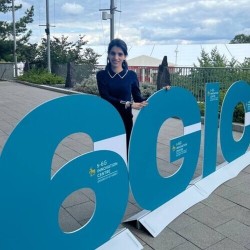
Marjan Abbasi Mosleh
ResearchResearch interests
- Performance Analysis in Wireless Communications
- Signal Processing for Wireless Communication
- Communication with Reconfigurable Intelligent Surfaces (RIS-Aided Communication)
- Application of Optimization Techniques in Wireless Communication
Research interests
- Performance Analysis in Wireless Communications
- Signal Processing for Wireless Communication
- Communication with Reconfigurable Intelligent Surfaces (RIS-Aided Communication)
- Application of Optimization Techniques in Wireless Communication
Publications
Reconfigurable intelligent surface (RIS) has emerged as a promising technology for enhancing the performance of wireless communication systems. However, the extent of this enhancement has yet to be defined in a simple and insightful manner, especially when RIS amplitude and phase responses are coupled. In this paper, we characterize the fundamental ergodic capacity limits of RIS-aided multiple-input multiple-output (MIMO), a.k.a. MIMO-RIS, when considering a practical amplitude response for the RIS, which is coupled to its phase shift response. By studying these fundamental limits, we provide insights into the performance of MIMO-RIS systems and inform the design and optimization of future wireless communications. Accordingly, we first derive a novel expression of MIMO-RIS ergodic capacity from a closed-form expression of the probability density function (pdf) of the cascaded channel eigenvalues. We then provide upper and lower bounds, alongside low SNR, high SNR, and large number of RIS element approximations to illustrate the dependence of the MIMO-RIS ergodic capacity on the amplitude and phase of RIS elements. These expressions helped us to define the maximum SNR gain of MIMO-RIS over MIMO systems. Next, simulations are used to validate the accuracy and correctness of our various capacity expressions. Furthermore, we investigate the impact of environmental factors, such as near-field or far-field path loss, on the MIMO-RIS ergodic capacity. Numerical results confirm the accuracy of our MIMO-RIS SNR gain expression and provide valuable insights into the performance of RIS-based systems in realistic scenarios. Consequently, this can contribute to the design of future wireless communications based on MIMO-RIS.